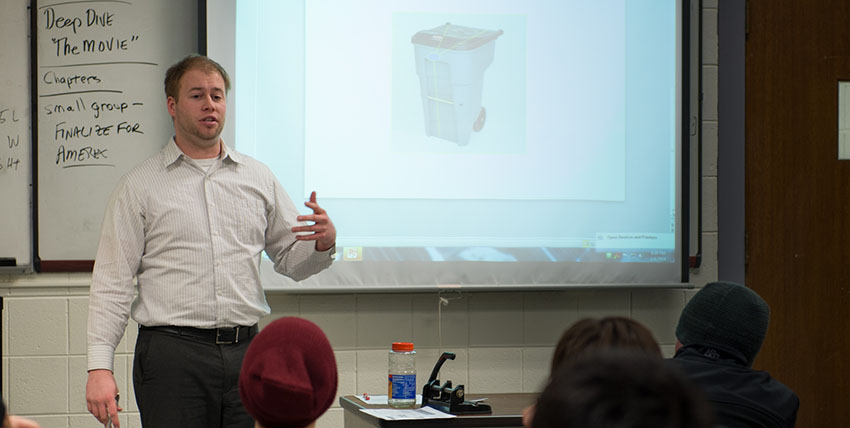Smartphone movie goggles, a garbage can strap, and a shopping cart dashboard were among the ideas that Department of Technology and M.B.A. students pitched recently in Turner Hall for their New Product Design and Development course.
“My idea was the shopping cart dashboard,” M.B.A. student Justin Reckamp said. “Not the sexiest idea alive, but I think there is some scale and potential with it.”
Reckamp’s idea might not have been flashy, but his fellow students agreed that adding dashboards to grocery carts so shoppers have a place to put their pen, list, and phones had some business potential. It was one of five proposals, out of seven products pitched, that the students chose to pursue for their semesterlong project to design new products.
Another successful proposal was pitched by M.B.A. student Elliot Farlow, who, anticipating a plan by the city of Bloomington to charge customers $3 for each overflowing trash can, thought up the idea of a press-button strap that would keep trash can lids tightly shut.
“Just imagine Christmas, move-in, move-out, tons of cases of beer that you guys don’t break down after Saturday night and you have just thrown them in the garbage can—they are going to overflow the can,” Farlow said, explaining the problem to the students.
The students liked the idea but also suggested it could be marketed to customers who want to keep rodents out of their trash. Other ideas that got a passing grade were a key chain smartphone stand, a wine box stand, and an idea put forth by Amerex, a firefighting product manufacturer that is using the class to develop a new piece of equipment.
“The objective of the course is that students come up with their own ideas. But we are open to companies that want to approach us and pitch an idea,” Associate Professor of Technology Louis Reifschneider said.

Technology Professor Louis Reifschneider said students’ product ideas must be simple enough to build and market in a semester but complex enough to serve a market need.
A different Amerex product and the smartphone goggles, which would allow users to watch a movie on their phone without having to hold the device in their hands, did not make the cut.
The class is a recent collaboration between the College of Business and the Department of Technology, and is the culmination of several years of partnership between Reifschneider and Marketing Associate Professor Peter Kaufman. The pair received the University’s Outstanding Team Research Award in 2012 for their research on innovative teaming of business and technology students working on the marketing of sustainable technologies: energy efficient lighting and bio-sourced materials.
“This course I would say is unique at the University because you have two different colleges where the classes are essentially co-taught and students are expected to work together,” Reifschneider said. “We have a common syllabus, but there are deliverables for M.B.A.s that are spelled out that are different than those for the Technology students.”
The point of the course is to give students the opportunity to come up with product ideas and then develop them through market research and product design into prototypes that could be manufactured into real products.
Last year, one student created storage bins for Jimmy John’s delivery bikers. The sandwich company didn’t bite, but a manager at Noodles and Company offered to buy a bunch of the bins for $50 each, Kaufman said.
“This is really real world,” Reifschneider said. “I tell the students when I advertise this class, ‘This is the closest thing to product design that you are going to see at a university.’”
Reifschneider said a large employer of Illinois State graduates recommended students develop experience working with others outside their discipline. In addition, he said he taught a product design class in the past but it had been missing real market analysis.
“Products are not created just because an engineer wants a job,” he said. “Products exist because they are solving needs. There’s been a market analysis involved. That was the missing link.”

Technology student Justin Sturtevant mills a block needed for his team’s full-scale model of a new product design for the Amerex Corp.
So last year, Reifschneider joined forces with Kaufman to start this class, which is offered to Technology seniors and M.B.A. students, many of whom are 10 to 15 years older than their undergraduate counterparts, making for an interesting diversity in backgrounds and age levels. The current class has 15 Tech students and six business students.
Now, with the product ideas chosen, the students will be split into five groups with at least one M.B.A. student on each team. The teams will have a project manager, fabricator, designer, and market researcher and will need to conduct market research in order to create a working prototype of the product that customers would want to buy.
“Often times, there is so much structure in a lot of the classes where students may not have a chance to experiment and fail, adjust, improve, and succeed,” Kaufman said. “We are taking some of the structure out. Granted we give the students parameters, but we say, ‘Go figure it out. Here is the design problem; go work on it. Create sketches, talk to customers, make low-fidelity prototypes, and then move it up. Get some additional feedback and fine-tune it.’”
STATEside will follow up on the course in May when the students present their finalized product prototypes.
Kevin Bersett can be reached at kdberse@IllinoisState.edu.

